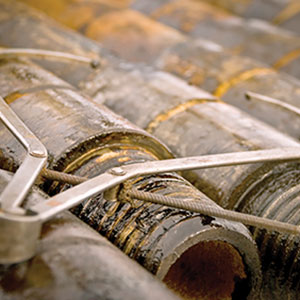For Drilling Pipe, Diameter Can Be a Complicated Matter

|
|
There’s nothing nominal about discussions of diameter. Make sure it’s clear in project specifications whether you’re talking inside our outside diameter. Source: iStock |
A borehole has a single diameter, but a drill string (rotary/reverse drill pipe, hollow stem augers, drive casing and sonic drill pipe) has two: inside diameter and outside diameter, affectionately referred to as ID and OD. Add well screen and casing to the mix and you potentially have five diameters to deal with when installing a well (borehole, drill string ID and OD, well casing ID and OD). Oh, and you may need temporary tremie pipe, and/or a permanent sounding tube. (I have even seen specifications calling for a separate “camera tube.”) It can get confusing. You get the idea. We’ve probably all been there.
It’s cumbersome to express both the ID and the OD every time you refer to a diameter, so we often just choose one, and refer to it as the “nominal diameter.” This is not really a correct use of the term. Sorry … very few drillers majored in English and/or engineering. The problem is that we’re inconsistent. Sometimes we’re referring to the OD and sometimes we’re referring to the ID. So what’s the driller’s logic?
General rule of thumb: Well casing is referred to by its ID because you need to know what you can fit inside it (i.e., a pump), while drill pipe and drive casing is generally referred to by its OD because you need to know how big a hole it makes.
An exception is a string of hollow stem augers (HSA), which have a huge difference between OD and ID because of the auger flights and bit diameter. Generally, when speaking about HSA with the non-drilling public, we reference the outside diameter. Internally, we switch back and forth between OD and ID when referring to hollow stem augers. A little drilling syntax: If we refer to the size in whole inches (e.g., “we need the 8-inch augers”) we mean the OD (the diameter of the borehole cut by the augers), but if the terminology ends in a fraction (e.g., “we’ll need the 8-and-a-quarter augers”) there’s a good chance we’re referring to the ID. The reasoning behind this is that the ID of the hollow stem is a more precise measurement than the OD. Why is the borehole size (OD) not a precise measurement? Maybe the augers wobbled as the hole was drilled, one of the auger teeth on the lead bit may be “bent out” or the driller modified the bit to make it bigger; any of these can lead to a borehole diameter larger than the auger flights. When in doubt, ask the driller to clarify what he means when discussing auger size.
Project objectives can often include the need for permanent conductor casing or possibly nested wells (multiple casings in a single hole). That’s where the “other” diameter starts to matter. A common monitor well material, schedule 40, 2-inch PVC well casing, for example, has an OD of 2.375 inches. If you want to nest multiple casings, you need to add some space between them so the diameter of the borehole gets larger. Let’s also not forget that many regulatory agencies have requirements for annular space between the casing and borehole wall. So if the state requires a 4-inch annulus for the grout seal and you’re building a 2-inch well, the borehole diameter is not 6 inches, but at least 6.375 inches.
Now let’s add surface casing, sometimes known as conductor casing. The important thing to remember is that the wall thickness of conductor casings varies, as depths, pressures and diameters factor into their structural integrity. The wall thickness of the conductors should always be considered when determining ID/OD. Additionally, if a conductor is threaded and coupled or has weld collars, the connections will have an even greater OD than the body of the pipe, which leads to another question regarding minimum annular regulations. Say you’re setting 10-inch threaded and coupled surface casing and the state regulations require a 4-inch annulus. Does that mean the acceptable borehole diameter is 14 inches (the outside diameter of the pipe plus the 4-inch annulus) or does the borehole have to be drilled to a 15-inch diameter (the outside diameter of the coupling plus the 4-inch annulus)? Regardless of the requirements, when using multiple conductors, remember to account for adequate space inside the first conductor(s) to drill a large enough boring through and beyond to accommodate the subsequent conductor(s) and its annular space (and don’t forget room for the tremie pipe).
If you want to be 100 percent sure you’re specifying the right size, you can always explicitly mention whether you mean ID or OD. It doesn’t hurt, and it’s actually less typing than writing out “nominal.” Besides, at the end of the day, geometry wins; it either fits or it doesn’t.
David S. Bardsley is business development manager for Directed Technologies Drilling. For more Bardsley columns, visit www.thedriller.com/bardsley.
Looking for a reprint of this article?
From high-res PDFs to custom plaques, order your copy today!

